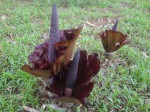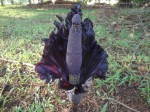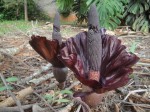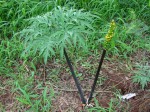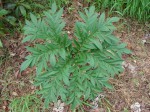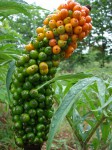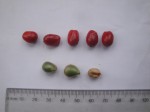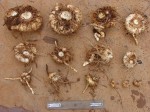Amorphophallus mossambicensis
Selected images: Click on each image to see a larger version and details of the record View all images (9)
The inflorescence begins to open in the early evening and the spadix emits a carrion-like odour to attract pollinators;
Open woodland; Lilayi
Nov 2011
Photo: Nick Wightman
Fully expanded flower shedding pollen the morning after the inflorescence first opened;
Open woodland; Lilayi
Nov 2011
Photo: Nick Wightman
Inflorescences can appear from late October through to late December;
open woodland; Lilayi
Nov 2011
Photo: Nick Wightman
The leaves of Amorphophallus are all pretty similar and are not a reliable means for distinguishing species;
Open woodland; Lilayi
Dec 2006
Photo: Nick Wightman
Ripening berries can range in colour from orange to red and are dispersed by birds such as Bulbils;
Open woodland; Lilayi
Dec 2006
Photo: Nick Wightman
The berries generally contain 1 to 2 seeds which are recalcitrant and germinate within several weeks from ripening;
Open woodland; Lilayi
Jan 2012
Photo: Nick Wightman
The tubers are generally roundish to depressed globose depending on age and produce rhizomatous offsets as a means of vegetative propagation;
Open woodland; Lilayi
Feb 2007
Photo: Nick
Detailed records: Display species records QDS maps by: Google Maps Point records by Google Maps
Species details: Click on each item to see an explanation of that item (Note: opens a new window)
| Synonyms: |
Amorphophallus swynnertonii Rendle Corynophallus mossambicensis Hydrosome mossambicensis |
| Common names: | |
| Frequency: | Widespread |
| Status: | Native |
| Description: |
Tuber, leaf and inflorescence description as per genus. A. mossambicensis is distringuished from A. abyssinicus subsp. unyikae by the spadix which is equal to or longer than the spathe, interrupted irregular ribs of the basal region inside the spathe tube and pollen morphology. |
| Type location: |
Mozambique |
| Notes: | |
| Derivation of specific name: | mossambicensis: from Mozambique |
| Habitat: | Open forest and miombo woodland. |
| Altitude range: (metres) | |
| Flowering time: | Oct-Dec |
| Worldwide distribution: | From Democratic Republic of Congo to Tanzania south to Zimbabwe and Mozambique. |
| FZ divisions: | S |
| Zambian distribution (Provinces): | Lk,S |
| Growth form(s): | |
| Endemic status: | |
| Red data list status: | |
| Insects associated with this species: | |
| Spot characters: | Display spot characters for this species |
| Images last updated: | Friday 1 April 2016 |
| Literature: |
Haigh, A. & Boyce, P. (2012). Araceae Flora Zambesiaca 12(1) Pages 41 - 42. |
Other sources of information about Amorphophallus mossambicensis:
Our websites:
Flora of Mozambique: Amorphophallus mossambicensisFlora of Zimbabwe: Amorphophallus mossambicensis
External websites:
African Plants: A Photo Guide (Senckenberg): Amorphophallus mossambicensisAfrican Plant Database: Amorphophallus mossambicensis
BHL (Biodiversity Heritage Library): Amorphophallus mossambicensis
EOL (Encyclopedia of Life): Amorphophallus mossambicensis
GBIF (Global Biodiversity Information Facility): Amorphophallus mossambicensis
Google: Web - Images - Scholar
iNaturalist: Amorphophallus mossambicensis
IPNI (International Plant Names Index): Amorphophallus mossambicensis
JSTOR Plant Science: Amorphophallus mossambicensis
Mansfeld World Database of Agricultural and Horticultural Crops: Amorphophallus mossambicensis
Plants of the World Online: Amorphophallus mossambicensis
Tropicos: Amorphophallus mossambicensis
Wikipedia: Amorphophallus mossambicensis
